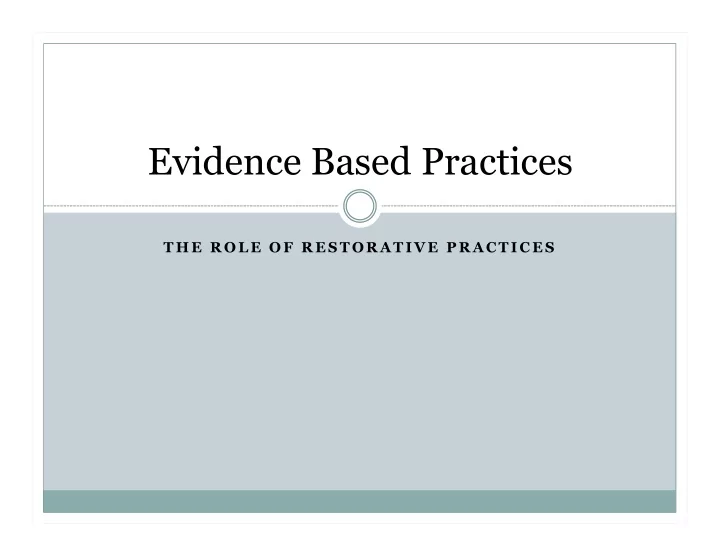

Evidence Based Practices T H E R O L E O F R E S T O R A T I V E P R A C T I C E S
Research Be a good consumer of research What is considered evidence-based programming? How does EBP research inform programming? How does data drive decision-making?
Four Key Principles Supported by Research Risk Principle (Who to Target) Need Principle (What to Target) Responsivity Principle (How to Match) Treatment Principle (Which Programs to Use)
JJSES Framework
BARJ Remains PA Mission JJSES aligns with BARJ in these BARJ ways Objectives Community EBP stresses the need to use research protection to guide practice, no matter what that practice is Accountability to Where research evidence does not victims and community exist, data and analysis should be collected/conducted Competency EBP for risk reduction addresses the development competency development part of BARJ
Summary of Benefits Vs. Costs (2010 Dollars) Program Benefits Costs/Person Net Aggression Repl. Training $36,043 $1,476 $34,567 Functional Family Therapy $37,739 $3,190 $34,549 Multi-D Treat. Foster Care $40,787 $7,739 $33,048 Nurse Family Partnership $30,325 $9,421 $20,904 Early Childhood Education $26,480 $7,420 $19,060 Adult Int. Sup: Supervision + $17,521 -$7,712 $9,809 Treatment Juvenile Drug Court $12,737 $3,024 $9,713 Adult Drug Courts $11,750 $4,099 $7,651 Adult Int. Supervision (no Treatment) -$556 -$4,050 -$4,606 Domestic Violence Treatment -$3,724 -$1,335 -$5,059 Scared Straight Programs -$6,031 $63 -$6,094
Evidence-Based Risk/Need Assessments Improves decision making Educates about delinquency risk factors Determines level of risk to recidivate Identifies and focuses attention on criminogenic needs Matches proper services to needs, based on risk Assists in determining appropriate levels of supervision Establishes measurable case-specific goals Allocates resources to achieve better outcomes for juveniles, families, victims and their communities Ultimately assists in risk reduction = community protection
Restorative Practices Where does RP fit in? What practices can be defined as evidence-based? Are current EBP practices considered restorative? What would be the criteria to consider other practices/processes restorative? How do we judge?
CSF Buxmont Aggression Replacement Training (ART) implementation Motivational Interviewing (MI) Restorative Reporting Centers (RRC) Essential Elements Other models – what to do when (FLS)
Where do we go from here Next steps? Future research projects How do we capture data? Questions/Comments
Contact Info Craig Adamson, Ph.D. craigadamson@csfbuxmont.org or craigadamson@iirp.edu
Recommend
More recommend